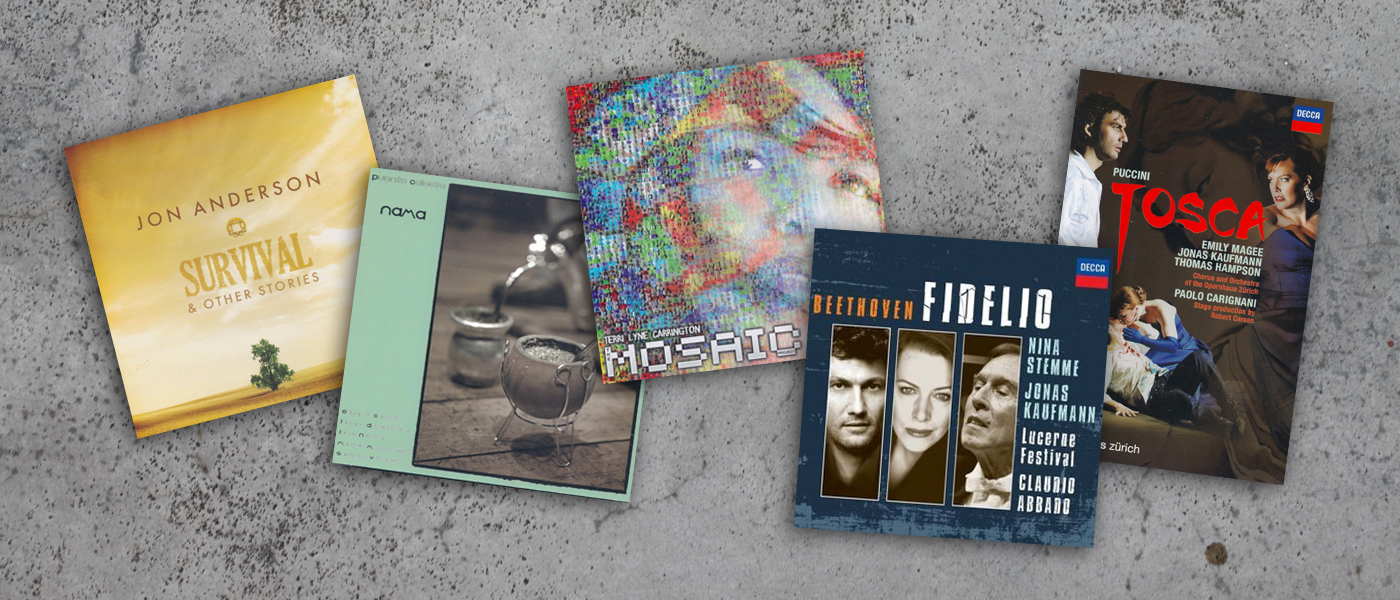Chick Corea, Stanley Clarke & Lenny White “Forever” Concord Records
- Performance:

- Sound:


From three renowned pioneers of the electric jazz fusion medium comes Forever, a surprising mix of back-to-the-roots, straight ahead acoustic jazz and electric fusion. The two-CD set, whose release roughly coincides with the 70th birthday of jazz pianist Chick Corea and 60th birthday of acoustic and electric bassist Stanley Clarke, celebrates the men’s perhaps momentary return to an earlier era when, on their way to forming the historic jazz fusion quartet Return to Forever in 1971, they briefly joined with drummer Lenny White to perform as a trio.
The first CD, recorded in 2009 at all-acoustic gigs in Oakland, Tokyo, and Seattle, finds its complement in a rehearsal session for the trio’s 2009 kick-off concert at the Hollywood Bowl. Joined on a few of those tracks by the great violinist Jean-Luc Ponty, vocalist Chaka Khan, and original Return to Forever guitarist Bill Connors, Corea, Clarke and White perform as if before an audience and on fire. Only some occasional pre- and post-performance chatter and spoken asides let on that these tracks come from a practice session, rather than a smoking live performance.
In addition to 10 tracks composed by Corea, two by Clarke, and one by Ponty, the artists visit classics by Thelonious Monk (“Hackensackâ€), John Coltrane (“Crescentâ€), and the Gershwin’s (“I Loves You Porgyâ€). The latter is one of two tracks on which Khan waxes poetic. Moving between jazz standards such as “On Green Dolphin Street†and “Waltz for Debby†and the driving jazz-rock of Corea’s “Captain Marvel,†Corea and crew play with such vitality that you can be sure that retirement is not in the cards.
For readers unfamiliar with these artists, pianist Corea, who turned 70 on June 12, is a 16-time Grammy winner, Downbeat Hall of Famer and NEA Jazz Master. He began his solo career in 1966, when he was 25, achieving equal fame as an acoustic artist and as an electric keyboardist with Return to Forever and the Elektric Band. In recent times, he won the 2007 Grammy for The Enchantment, a duet disc with banjo master Bela Fleck, and the 2009 Grammy for Five Peace Band. 2010 saw the debut of his Freedom Band quartet, which he formed with three of the other players on Five Peace Band, Roy Haynes, Christian McBride, and Kenny Garrett. His discography is enormous.
Philadelphia-born bassist Clarke’s enduring claim to fame is his work with the Fusion band Return to Forever and his work for television and film. Honored with Bass Player magazine’s Lifetime Achievement Award, he won a Grammy in 1975, Rolling Stone’s first “Jazzman of the Year,†and ten straight “Best Bassist†accolades from, of all sources of cultural greatness, Playboy. His impressively huge discography includes eight albums with Return to Forever, and the scores of enough feature films to keep you occupied for a very long time.
New York-born White, who turns 62 later this year, began his career performing with Jackie McLean. In 1969, he took part in Miles Davis’ classic Bitches’ Brew, and played with Freddie Hubbard before joining Return to Forever in 1972. Before recording Forever, he recorded Jazz in the Garden with The Stanley Clarke Trio.
Elisabeth Schumann “Silver thread of song / Perfect Prima Donna” EMI Classics
- Performance:

- Sound:

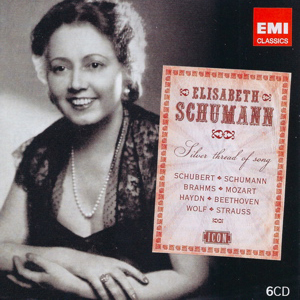
EMI has done its Elisabeths proud. With its two ICON box sets, Elisabeth Schumann: Silver thread of song, and Elisabeth Schwarzkopf: Perfect Prima Donna, it has provided us with a virtually unbroken stream of great soprano interpretations of Mozart arias, German lieder (art song), operetta, and song from 1926 through 1974. The bargain-priced sets may be a mixed blessing for folks who lack copies of texts and translations, but for those familiar with the more popular creations of Bach, Schubert, Schumann, Brahms, Mozart, Haydn, Beethoven, Wolf, both Strausses, and other greats, Schumann’s six packed CDs and Schwarzkopf’s ten are a treasure trove.
Although neither woman held the monopoly on great lieder interpretation during her prime, Schumann (1888-1952) and Schwarzkopf (1915-2006) are certainly among the finest soprano representatives of the lieder tradition on record. All the more exciting to discover, in Schumann’s case, 17 tracks that EMI has never before transferred to CD. In fact, five priceless songs were only available once in the LP era, on a terrible Rococo transfer. As long as you can forget everything you’ve ever learned about authentic early music performance, Schumann’s interpretations of Monro’s “My lovely Celia,†Arne’s “Where the bee sucks,†and Carey’s “Pastorale: Flocks are sporting†are sheer bliss.
These rare tracks (including Schumann’s whistling) also underscore major differences between the two artists. Compare, for example, Schumann’s two excerpts (including The Evening Prayer duet) from Humperdinck’s Hansel und Gretel, recorded when she was 47, and Schwarzkopf’s exerpts from the same opera, recorded when she was a fresher 32.
Schumann’s more slender voice is all joy, light, and smiles. Her instrument, shallow in the low range and tangy in the middle, blossoms to produce miraculously pure, silvery sounds on high. Equally important, her spirit seems truly innocent. You can almost imagine her a babe in the woods, voicing feelings without artifice as they naturally arise from the heart. Yet the singing is paradoxically some of the most nuanced and subtly inflected on record. And in the Evening Prayer duet, an early example of double-tracking in which she sings both Hansel and Gretel, her angelic communication is unparalleled.
Schwarzkopf, in freshest voice, is a very different animal. As irresistible as her unique sound and marvelous head voice may be, there is always the sense of an ever active mind carefully choosing which of her huge cache of expressive sounds is most appropriate at any given moment. Dueting with Irmgard Seefried, her singing swings between supremely artful and calculatingly arch. This tendency only grew more pronounced as her relationship with her future husband, EMI recording producer Walter Legge, developed into one of rigorous, unrelenting repetition of notes and phrases, often for hours at a time, until she got it “right.â€
Schwarzkopf’s intellect and vocal apparatus made for some of the finest interpretations of German operetta, Richard Strauss’ Marschallin and Four Last Songs, and Mozart’s Countess. (Examples of all are included in her ICON box, in one version or another). Yet compare her recordings Richard Strauss’ “Freundliche Vision†and “Morgen†with Schumann’s, and it’s easy to understand why, when Strauss toured the United States with Schumann in 1921, he once remarked, “One cannot sing more beautifully than that, no, one cannot sing more beautifully than that.â€
Troubadours “The Rise of the Singer-Songwriter” Concord HRM 32078 00 (CD and DVD)
- Performance:

- Sound:

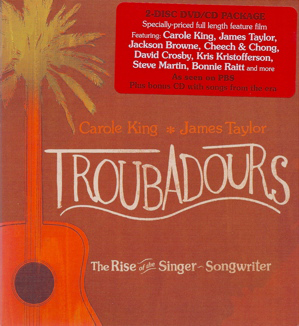
Is it right for music reviewing to be this much fun? Troubadours, Concord’s two-disc, DVD-CD package, is one grand trip through memory lane. Centering on the role that The Troubadour, Doug Weston’s folk music club in Los Angeles, played in the rise of the singer-songwriter / country rock era of the late 1960s and early 1970s, the DVD Troubadours includes vintage performances and / or interviews with Carole King, James Taylor, Jackson Browne, Elton John, Steve Martin, David Crosby, Bonnie Raitt, Cheech & Chong, Kris Kristofferson, Joni Mitchell, JD Souther, Eagles (not “the Eagles), and many other greats of the period. Complete with a separate CD that contains seminal tracks by Taylor, John, Raitt, Kristofferson, King, Linda Ronstadt, Tom Waits, Randy Newman, Warren Zevon, and Little Feat, this is the package that conveys what the music of these greats meant to the youth and adults of an earlier era, and continues to mean in 2011.
Besides the extraordinary performance footage from the present and past, the host of personal reminiscences from the veterans of The Troubadour and inhabitants of Los Angeles’ Laurel Canyon shed light on the joys and mysteries of the period. “Everybody smoked grass, literally everybody did,†says one of the many personalities. “Grass was the sacrament.â€
“You got high for the first time, and you ask, ‘Wow. What else they been lyin’ about?’†says Cheech. “The sex was great in the period between the birth control and AIDS,†adds Cosby. If there were gay people around, and you can be sure as hell there were plenty, they remain either anonymous or too blitzed out to speak.
And then came down the downside. “When we started doing coke and heroin, things went to shit, as they will,†says Cosby. Immediately, the footage switches to Taylor’s manager, who suggests what he had to do to get his increasingly addicted star onto the stage and through his tour. Taylor takes up the thread, reminiscing to Carole King that he finally got clean in 1983. As he explains, he is one of a minority that made it out the other side into recovery; 85% die of their addiction.
“How long can free love and pot exist as a cultural foundation?†asks Martin. “It can’t really.†But while it did, in this rich period when the feminist and anti-war movements went hand-in-hand with music, drugs, and deep-rooted personal commitment, the music was great. And it’s the music you’ll enjoy on this fabulous DVD. For the remainder of the stories, check with the living and all the tell-all biographies and autobiographies you can find.
The following reviews first appeared at sfcv.org, the website of San Francisco Classical Voice
Meredith Monk “Songs of Ascension” ECM New Series
- Performance:

- Sound:

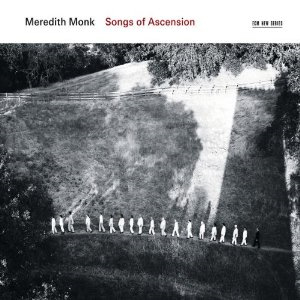
Composer and performance artist Meredith Monk’s uncanny ability to express universal truths through highly evocative, elemental sounds has kept her in the forefront of contemporary music for over four decades. Not long after her groundbreaking collaboration with Bay Area women’s vocal ensemble Kitka, Songs of Ascension (2008), her latest recording for ECM New Series, confirms that her work remains as vital as ever.
The composition – performance piece really – also shares a new aspect of Monk’s work: the incorporation of classical string quartet and instruments from the East and West into her writing for voices. Inspiration for the workcame in part from an exchange with poet and Zen Buddhist priest Norman Fischer. When Fischer referenced Paul Celan’s writings about the “Song of Ascents,†fifteen of the Psalms said to have been sung by people ascending to heaven during pilgrimages, Monk began exploring the association of ascension with an upward movement toward heaven.
At the same time, visual artist Ann Hamilton invited her to perform in an eight-story tower she had designed on the Oliver Ranch in Geyserville. The tower, conceived to suggest the shape of double helix DNA, includes two interior spiraling staircases that rise up opposite each other, only intersecting at the top. Intrigued by the connection with ascension, and certainly by the fundamental nature of the design and the unusual acoustic, Monk designed a site-specific piece that included her own seven-person vocal ensemble, vocalists of The M6 and Montclair State University Singers, the Todd Reynolds Quartet, and other musicians capable of carrying their instruments up the stairs. (New music pioneer Pauline Oliveros premieres her Tower Ring on the same site on June 4 and 5).
Recorded at the Academy of Arts and Letters in New York, Songs of Ascension reveals Monk far more a primordialist than a minimalist. Whoops, gongs and drums suggest ancient rituals from faraway lands, while consoling vocal harmonies and vaguely Native American vocalizations bring her musical language close to the heart. There is an extraordinary track on which siren-like waves of sound pass between correctly spaced stereo speakers while singers vocalize at different specific points in the sound field.
At times, the string quartet plays with almost savage intensity, joined by rattles and clapping that simulates the unusual rhythms of Indian ragas. But then the music subsides, leaving the silence punctuated by occasional whoops and peeps. As the piece evolves, Monk and the other singers seem to emote from a place before vocalizations formed into identifiable words. The sounds are part-prehistoric, part interplanetary, with baby-like cries and wails summoning forth images of beings hailing each other across vast spaces.
Songs of Ascension is so all-encompassing in scope as to call for documentation in both hi-resolution download formats and surround-sound Blu-ray. Even in its current CD format, Monk’s latest masterpiece immerses listeners in a rare experience of grace and beauty.
Lorraine Hunt Lieberson: Berlioz Les Nuits d’Été, Handel Arias “Philharmonia Baroque Orchestra, Nicholas McGegan” Philharmonia Baroque Productions
- Performance:

- Sound:

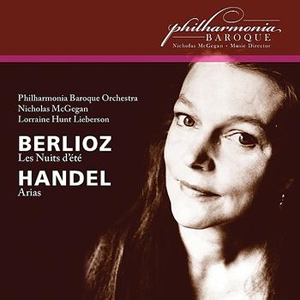
Almost everything extraordinary about the heart-searing artistry of mezzo-soprano Lorraine Hunt Lieberson (1954-2006) sings out on her two never-before-released live collaborations with Philharmonia Baroque Orchestra and conductor Nicholas McGegan. Issued on a single disc, the 1991 performance of Handel arias and 1995 rendition of Berlioz’s Les Nuits d’été are so deeply felt by all concerned that it’s no wonder that many members of Philharmonia Baroque struggled to hold back tears as they accompanied the Bay Area native.
The Berlioz is a revelation. Beyond its priceless importance as Hunt Lieberson’s sole recorded traversal of the six-song cycle, and the only available recording of the work on period instruments, it serves as testimony to her incomparable ability to transform grandly scaled romantic outpourings into seemingly private and extremely intimate confessions.
Lest anyone be tempted to pigeonhole the violist turned soprano turned mezzo as best in music of sadness and grief, she begins Les Nuits d’été with an extremely light and carefree Villanelle. Here we encounter the voice of youth, filled with the promise of springtime and the scent of strawberries in bloom.
The contrast with the ghostly intimate rendition of Le Spectre de la rose (The Ghost of the rose) is profound. Hunt Lieberson begins the song in a near whisper of a voice, as if reaching out from another plane. When she slows down to sing (in translation), “Here lies a rose which all kings might envy,†her focus becomes so singular that you find yourself caring deeply about this withered flower, sacrificed in the name of love, as it sings of memories that it has taken to its grave.
Hunt Lieberson intensifies her emotional outpouring in “Sur les lagunes†(On the lagoons). Listen to how deep and quiet she becomes on the world “linceul†(shroud). The song’s end, with her moan perfectly mirrored by the cellos and low basses of Philharmonia Baroque, is a work of art.
Most singers open their voices to operatic extremes at the start of the fourth song, “Absence,†when they call out, “Reviens, reviens, ma belle aimée!†(Return, return my beloved!) Hunt Lieberson does get louder, but less by sheer volume than by miraculously expanding the breadth of the voice as if expressing broader emotion. There’s less of a sense of pushing forward and out in volume, and more a feeling of expanding the vocal compass to traverse the space between two distant hearts. When I played this song for my husband, who studied voice with Lorraine’s mother, contralto Marsha Hunt, perhaps 30 years ago as her daughter Lorraine accompanied on piano, he declared with certainty, “She learned that from her mother.â€
The orchestra’s distantly recorded, magically spare accompaniment works especially well in “Au Cimitière (Clair de lune)†(At the cemetery ((Moonlight)). You can virtually smell the perfume in Hunt Lieberson’s voice when she sings of the half-closed marvels of Peru. Equally special are her ghostly murmurs, beautifully supported by Marc Schachman’s oboe. What a contrast with the energetic lightness of the final song, “L’ÃŽle inconnue†(The unknown isle), which ends with a hint of seductive excitement. If you share my feeling that Berlioz often goes on far too long, milking romantic sentiments for even more than they are worth, Hunt Lieberson’s Les Nuits d’été may very well give you pause. It will surely touch you to the core.
The Handel arias, recorded on an analogue cassette the night before fire swept through the East Bay hills, were sung in preparation for Harmonia Mundi’s Handel Arias recording with the then-named Lorraine Hunt and PBO under McGegan. Not all of them appear on the HMU disc. Editing and Mastering engineer David v.R. Bowles (Swineshead Productions), who plays violoncello on the Berlioz and is also McGegan’s partner, has done miracles to make the arias sound as if recorded on far better equipment.
I leave it to you to discover their joys. I can’t imagine anyone who loves the human voice at its expressive best living without this disc.


